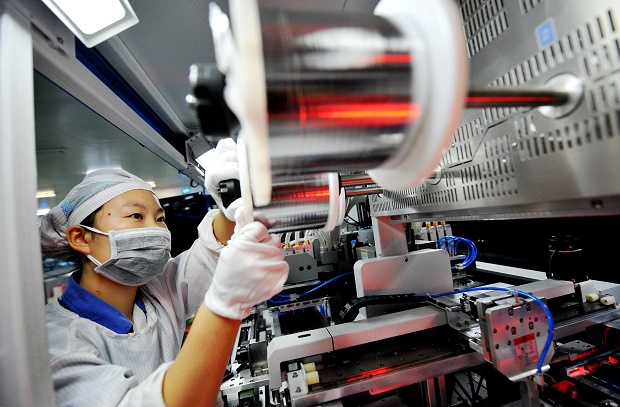
In this Oct. 11, 2015 photo, a woman works with equipment in a factory manufacturing solar power panels in Shangrao in central China’s Jiangxi province. AP
BEIJING, China — Manufacturing activity in China shrank at its fastest rate in four years in February, government data showed Tuesday, a fresh sign of sustained weakness in the world’s second-largest economy.
The official Purchasing Managers’ Index (PMI), which tracks activity in factories and workshops, fell to 49.0 last month, figures from the National Bureau of Statistics (NBS) showed.
It was the lowest figure since 49.0 in November 2011, and was below the median forecast of 49.4 in a Bloomberg survey of economists.
READ: PH ready to adopt China’s manufacturing runaways | Jollibee takes full control of China manufacturing unit
A reading above 50 signals expanding activity in the vital sector, while anything below indicates contraction, and investors watch the index closely as the first available official indicator of the country’s economic health each month.
It was the seventh consecutive month that the official index showed contraction, which Bloomberg News said was the longest such series on record.
The figures came only hours after the central People’s Bank of China cut the amount banks must hold in reserve, in Beijing’s latest attempt to tackle slowing growth.
It trimmed the so-called reserve requirement ratio (RRR) for financial institutions by 0.50 percentage points, freeing up more funds for them to lend.
China’s economy, a vital driver of global expansion, grew 6.9 percent last year, its weakest rate in a quarter of a century.
China’s leaders — who targeted growth of “about seven percent” — are looking to transform the economy away from the investment and exports of the past to one more oriented towards domestic consumption, but the transition is proving bumpy, and the growth slowdown has alarmed investors worldwide.
Tuesday’s NBS figures showed market demand “continued to fall” in February as the new orders sub-index slipped to 48.6 from 49.5 in January, while employment worsened with the jobs indicator falling by 0.2 points to 47.6.
‘Falling off a cliff’
The private Caixin Purchasing Managers’ Index, which has a greater emphasis on smaller firms, came in at 48.0 for February, the lowest in five months, the Chinese financial magazine said in a joint statement issued with data compiler Markit.
“The index readings for all key categories including output, new orders and employment signaled that conditions worsened, in line with signs that the economy’s road to stability remains bumpy,” He Fan, an economist at Caixin Insight Group, said in the statement.
He urged policy makers to adopt “moderate stimulus policies” and give stronger support to the economy to “prevent it from falling off a cliff”.
But investors took the figures in their stride, with the benchmark Shanghai Composite Index slipping 0.25 percent in morning trade, while the Shenzhen Composite Index, which tracks stocks on China’s second exchange, edged up 0.06 percent.
Julian Evans-Pritchard, an economist with research firm Capital Economics, said Tuesday that the RRR cut was prompted by the PMI figures, and came despite a spike in loan growth in January, showing “policymakers are now prioritising growth over long-term credit risks”.
Last month’s PMI may have been distorted by factory suspensions during the Chinese New Year, which fell on February 8 this year.
But ANZ analysts Raymond Yeung and Louis Lam pointed out that the average PMI level for January and February stood at 49.2, below the breakeven point.
“Industrial production is likely to remain weak in Q1 2016, and growth could further trend down, especially for overcapacity sectors such as steel, cement and coal,” they said in a note.
The government will have to make proactive fiscal moves to support investment, increase deficit spending and boost the money supply if it is to maintain a 6.5-7.0 percent growth rate this year, they said.

